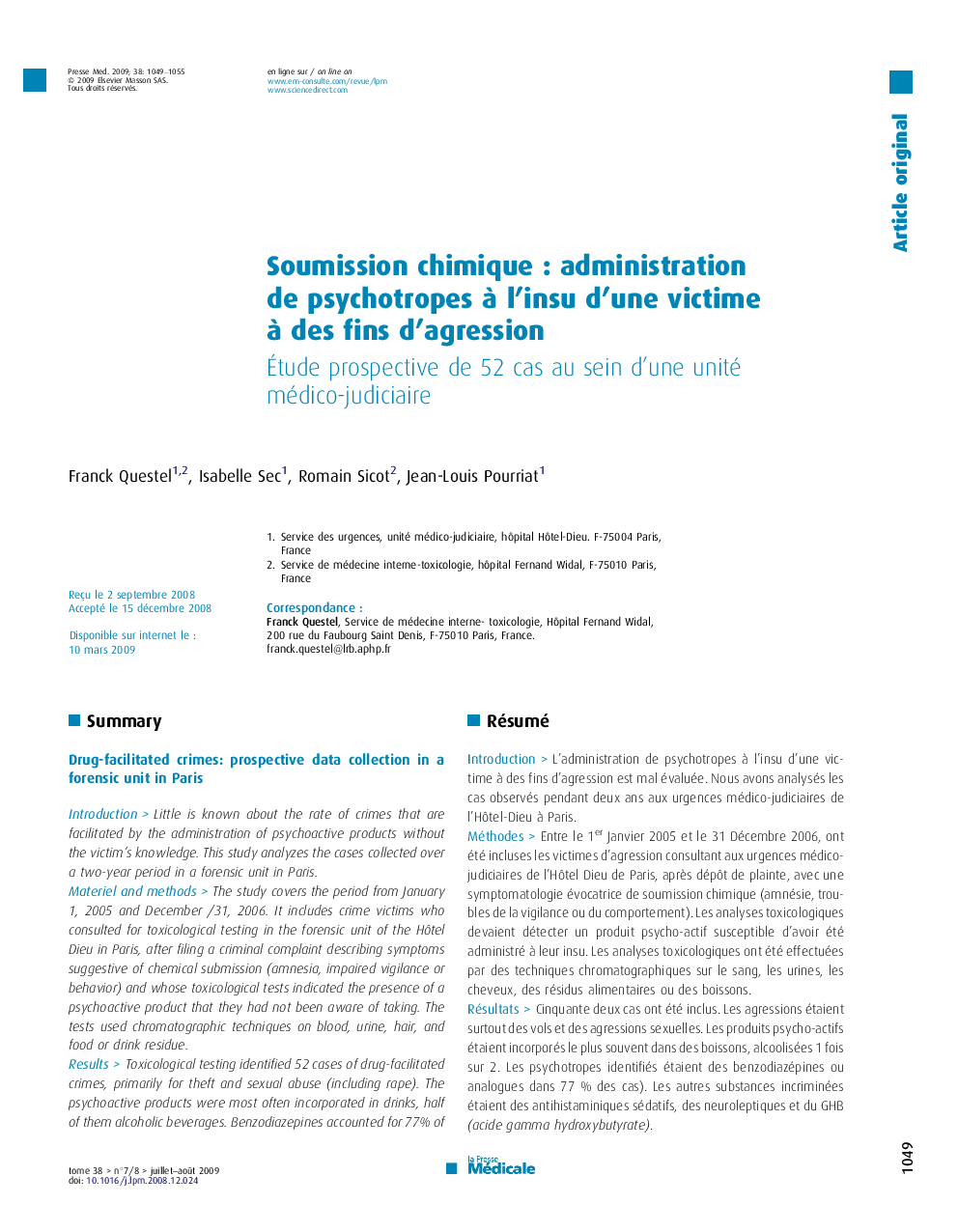| Article ID | Journal | Published Year | Pages | File Type |
|---|---|---|---|---|
| 3821043 | La Presse Médicale | 2009 | 7 Pages |
RésuméIntroductionL’administration de psychotropes à l’insu d’une victime à des fins d’agression est mal évaluée. Nous avons analysés les cas observés pendant deux ans aux urgences médico-judiciaires de l’Hôtel-Dieu à Paris.MéthodesEntre le 1er Janvier 2005 et le 31 Décembre 2006, ont été incluses les victimes d’agression consultant aux urgences médico-judiciaires de l’Hôtel Dieu de Paris, après dépôt de plainte, avec une symptomatologie évocatrice de soumission chimique (amnésie, troubles de la vigilance ou du comportement). Les analyses toxicologiques devaient détecter un produit psycho-actif susceptible d’avoir été administré à leur insu. Les analyses toxicologiques ont été effectuées par des techniques chromatographiques sur le sang, les urines, les cheveux, des résidus alimentaires ou des boissons.RésultatsCinquante deux cas ont été inclus. Les agressions étaient surtout des vols et des agressions sexuelles. Les produits psycho-actifs étaient incorporés le plus souvent dans des boissons, alcoolisées 1 fois sur 2. Les psychotropes identifiés étaient des benzodiazépines ou analogues dans 77 % des cas). Les autres substances incriminées étaient des antihistaminiques sédatifs, des neuroleptiques et du GHB (acide gamma hydroxybutyrate).ConclusionLes victimes doivent être médicalisées rapidement afin de ne pas retarder les analyses toxicologiques. Des techniques chromatographiques doivent compléter les techniques immunochimiques de sensibilité et de spécificité insuffisantes. Le recensement des observations doit se poursuivre afin de quantifier le phénomène et surveiller l’émergence de nouveaux produits.
SummaryIntroductionLittle is known about the rate of crimes that are facilitated by the administration of psychoactive products without the victim's knowledge. This study analyzes the cases collected over a two-year period in a forensic unit in Paris.Materiel and methodsThe study covers the period from January 1, 2005 and December /31, 2006. It includes crime victims who consulted for toxicological testing in the forensic unit of the Hôtel Dieu in Paris, after filing a criminal complaint describing symptoms suggestive of chemical submission (amnesia, impaired vigilance or behavior) and whose toxicological tests indicated the presence of a psychoactive product that they had not been aware of taking. The tests used chromatographic techniques on blood, urine, hair, and food or drink residue.ResultsToxicological testing identified 52 cases of drug-facilitated crimes, primarily for theft and sexual abuse (including rape). The psychoactive products were most often incorporated in drinks, half of them alcoholic beverages. Benzodiazepines accounted for 77% of the cases. Other substances, found more rarely, included antihistamines, neuroleptics, and GHB.ConclusionAppropriate samples must be taken from victims rapidly to enable toxicological analysis. Chromatographic analysis must supplement immunological analysis, which is not sufficiently specific or sensitive. The collection of this information must continue in order to quantify the phenomenon and monitor the emergence of new products.
